- HOME
- Products
- HPLC Columns
- CAPCELL PAK AQ Type
C18 column applicable in 100% aqueous mobile phase
We provide you with a solution for stable analysis for high polarity compound retention with 100% aqueous mobile phase.
Stable reproducibility with 100% aqueous mobile phase
Although retention can be increased by lowering the rate of organic solvent in the mobile phase with the C18 column, reproducibility cannot be realized with 100% aqueous mobile phase.
CAPCELL PAK C18 AQ addresses this by assuring good reproducibility even with 100% aquatic moble phase by optimizing the introduction of octadecyl group and polymer coating of the base packing material with a novel polymer.
Have you ever considered high polarity compound analysis using 100% aqueous mobile phase?
The CAPCELL PAK C18 AQ column achieves good reproducibility with 100% aqueous mobile phase, and is durable as well.
Features
The highest surface polarity among C18 columns
With the highest surface polarity among C18columns, the AQ type enables strong retention and high separation of high polarity compounds. Furthermore, it enables the use of 100% aqueous mobile phase, which used to present problems in reproducibility with the conventional ODS columns.
Additionally, since it is coated with a polymer, the peak profile of basic compounds is free from tailings and, consequently, extremely good.
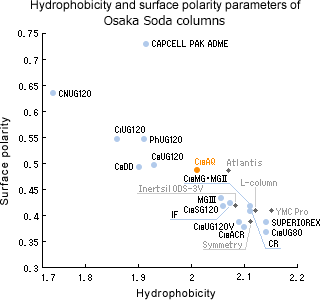
Excellent retention capacity for high polarity compounds
Designed for high surface polarity, CAPCELL PAK C18 AQ is the only column among CAPSEL PAK products that enables stable analysis with 100% aqueous mobile phase. Moreover, it has excellent retention capacity for high polarity compounds.
Fig. 1Analysis of nucleic-acid bases
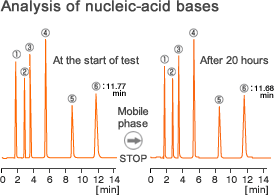
- Column:
- 4.6mm i.d.×150mm
- Mobile phase:
-
20mmol/L KH2PO4,
20mmol/L K2HPO4 - Flow rate:
- 1.0mL/min
- Temperature:
- 40°C
- Detection:
- UV254nm
- Sample:
-
(1) Sodium sulfite (2) Cytosine
(3) Thymine (4) Uracil
(5) Adenine (6)Guanine
Close
Fig. 2Analysis of water soluble vitamin B group
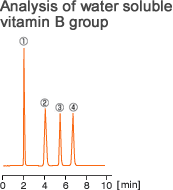
- Column:
- CAPCELL PAK C18 AQ S3
4.6mm i.d.×75mm - Mobile phase:
- 10mmol/L CH3COONH4
- Temperature:
- 40°C
- Flow rate:
- 1.0mL/min
- Detection:
- UV254nm
- Sample:
-
(1) Nicotinic acid
(2) Pyridoxal
(3) Pyridoxine
(4) Nicotinamide
(Concentration is 100μL/mL for all) - Injection volume:
- 10μL
Close
Higher-than-expected separation capacity even with 100% organic solvent mobile phase
Since the type of polymer coating and the introduction rate of C18 have been modified to enable the use of 100% aqueous mobile phase, hydrophobic compounds can be eluted faster with 100% organic mobile phase.
Fig. 3Analysis of lipid soluble vitamins
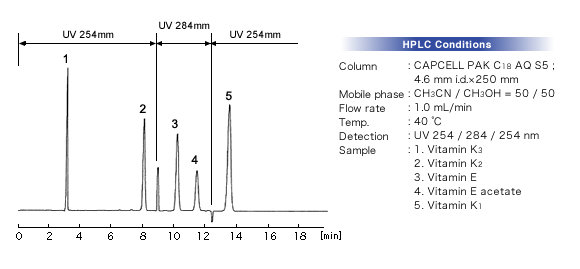
Close
High resistance to acid and alkali
Poor durability is a problem in columns designed for use with 100% aqueous mobile phase. However, the AQ has been designed to improve resistance to acid and alkali with a polymer coating and the introduction of a unique C18 group.
AQ shows excellent resistance to acid and alkali in comparison with other columns capable of using 100% aqueous mobile phase, in which the resistance tends to deteriorate quickly.
Fig. 4Results of durability test
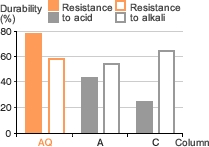
Test conditions for acid resistance
- Mobile phase:
-
(A)2vol% TFA,H2O(pH1)
(B)2vol% TFA,CH3CN
B 65% (20min) → 0% (60min)
→ 98% (5min) → 65% (5min) - Flow rate:
- 1.0mL/min
- Temperature:
- 60°C
- Detection:
- UV254nm
- Sample:
- Uracil, amyl benzene
Test conditions for alkali resistance
- Column:
- 4.6mm i.d.×150mm
- Mobile phase:
-
4mmol/L Na2B4O7/CH3OH
=90/10 (pH10.0) - Flow rate:
- 1.0mL/min
- Temperature:
- 50°C
- Detection:
-
UV254nm
* Survival rate (%) of retention factor (k) of benzyl alcohol after 20 hours of dipping
Close
Good peak profile also with basic compounds
The AQ type column comprises packing material coated with polymer; least influenced by silanol, and, consequently, is able to elute the basic compounds as a sharp peak without tailing.
Fig. 5Analysis of pyridine/phenol
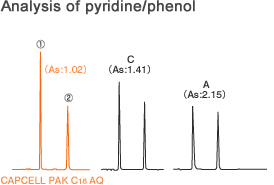
- Column:
- 4.6mm i.d.×150mm
- Mobile phase:
- CH3CN/H2O=30/70
- Flow rate:
- 1.0mL/min
- Temperature:
- 40°C
- Detection:
- UV254nm
- Sample:
-
(1) Pyridine (2) Phenol
- As:
- Tailing factor
Close
Realization of low pressure allows a length of 250 mm and a particle diameter of 3 µm
Through the selection of silica gel accurately graded for AQ, high number theory plate (NTP) in 5 and 3 µm particle with an amazingly low pressure became available.
The changeover from a particle of 5 µm to 3 µm has enabled improved separation and fast analysis. Which option would you prefer to pursue in the analysis of high polarity compounds?
Fig. 6Column pressure
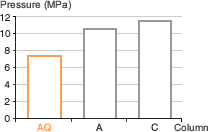
Conditions for comparison of column pressure
- Column size:
- 4.6mm i.d.×150mm
- Mobile phase:
- H2O/CH3OH=50/50
- Flow rate:
- 1.0mL/min
- Temperature:
- 40°C
Close
Fig. 7Analysis of nucleic bases/nucleoside
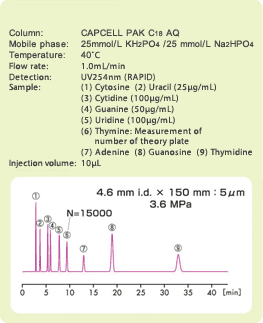
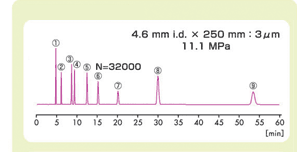
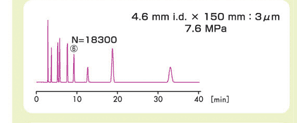
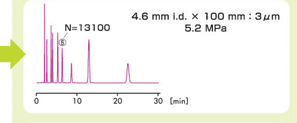
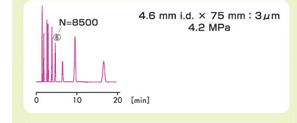
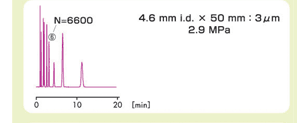
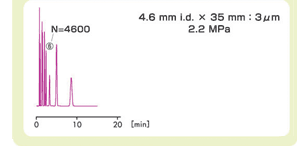
Close
Physical properties
| Functional group |
Particle diameter (μm) |
Pore diameter (nm) |
Specific surface area (m 2/g) |
C% | Density (µmol/m 2) |
Range of applicable pH |
USP |
|---|---|---|---|---|---|---|---|
| Octadecyl group | 3 | 8 | 330 | 12 | 1.7 | 2~9 | L1 |
| Octadecyl group | 5 | 8 | 300 | 11 | 1.7 | 2~9 | L1 |


